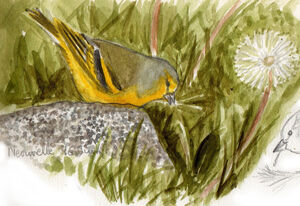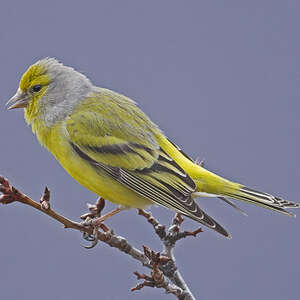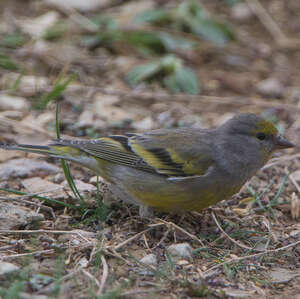Citril Finch
Carduelis citrinella - Venturon montagnard
Identification
The Citril Finch, slightly larger than the Eurasian Serin, has a uniform appearance with a longer bill and tail. The adult male has a yellow-green upper part with blackish wings whose feathers have yellowish-green edges. The large and medium coverts are also decorated with the same colour, creating two distinctive wingbars. The rump is a clearly yellow but the most noticeable feature is the grey head and sides of the neck, contrasting with the yellowish face. The wear of the feathers in winter season gives the coat a more streaked appearance towards the end of winter, which is further accentuated in the early spring. The underside of its body is intensely yellow. The forked tail is blackish with the rectrices finely fringed with whitish or yellowish. The legs are pink. The adult female is generally grayer, especially on the sides and back, and considerably duller. It has less yellowish-green, especially on the face. The mantle is vaguely streaked. The two wingbars, less colourful than those of the male, are still clearly visible.
The adult Citril Finch may possibly be confused with the Eurasian Siskin or even the European Greenfinch in flight, but it has no yellow at the base of the tail. The juvenile is even more dull and has a browner colour on the back. The mantle is beige-fawn marked with dark brown. The underside is whitish finely streaked with brown. The face is vaguely tinged with yellow. It may be mistaken for a young Eurasian Melodious Meadowlark. However, the wing and tail pattern is different. The young citril finch has well visible rufous to pale fawn wingbars which a young meadowlark never has. Inversely, it never has any white in its wings or tail. The total absence of yellow or greenish in its plumage immediately differentiates it from all the other young members of the Serinus genus, except the Canary Serin.
Subspecific information monotypic species
Foreign names
- Venturon montagnard,
- Verderón serrano,
- milheirinha-serrana,
- Zitronenzeisig,
- citromcsicsörke,
- Citroensijs,
- Venturone alpino,
- citronsiska,
- Sitronirisk,
- stehlík citrónový,
- zvonohlík citronový,
- Citronsisken,
- sitruunahemppo,
- llucareta europea,
- Næfurfinka,
- osetnik (zwyczajny),
- citronģirlicis,
- konopeljščica,
- Лимонный (канареечный) вьюрок,
- シトロンヒワ,
- 桔黄丝雀,
- citronsiska,
- 檸檬黃絲雀,
Voice song and call
The usual call is similar to the Eurasian Siskin's. It is a plaintive tsi-húe or a repetitive tchèt issued while flying. The song, varied and melodious, similar to that of the Eurasian Siskin, consist of brief phrases interspersed with cries. Quite different from the Eurasian Serin's, it is often uttered during a short nuptial flight in circles.
Habitat
The Citril Finch is commonly found in mountain forests, typically starting from around 700 meters in elevation and reaching as high as treeline, often in spruce-meadow clearings close to alpine pastures. It is quite prevalent on the edges of coniferous high-altitude forests, on rocky slopes dotted with spruces and shrubs. It can sometimes descend lower in the winter.
Behaviour character trait
The Citril Finch is a very social bird outside the breeding period. It is easy to observe when it feeds in small flocks or when it is perched in larch trees in loud groups.
Its behaviour strikingly resembles that of the Eurasian Siskin with its bouncing flight and warbling cries, even in spring when the pairs are spread out. It can be sedentary or partial migrant depending on the area, moving down to the valleys in winter (altitudinal migration). Birds hatched in the French prealps have been found in Catalonia in winter.Dietfeeding habits
The Citril Finch has a mixed diet. It consumes a wide variety of seeds, sometimes acrobatically perching on the stems of grasses, but also pecking at the ground in the grass. In the latter case, it shows very docile behavior, allowing the observer to come close to within two meters while it is busy pecking. The Citril Finch also eats insects.
Reproduction nesting
The nesting season begins in the last week of April or the first half of May. The nest is usually placed in a spruce tree a few metres above the ground. It is composed of dry stems, twigs, lichen, moss and rootlets. It is padded with kapok and feathers. The 4 or 5 blue-green eggs, spotted with brown and blackish, are incubated for 14 days by the female. The stay of the young in the nest lasts 17 or 18 days. The female completes 1 or 2 broods per season.
Geographic range
The range of the Citril Finch is restricted to the high mountains of Western and Central Europe. In France, it can be found in the Vosges, the Jura, the Massif-Central, the Alps, and the Pyrenees. In Spain, it is mainly spotted in the Cantabrian Mountains and the sierras of the Old Castille. It is also observed in the Italian and Austrian Alps.
Threats - protection
Sources of information
- IOC World Bird List (v15.1), Gill, F and D Donsker (Eds). 2025-12-07.
- Atlas des oiseaux de France métropolitaine. Nidification et présence hivernale. , Issa Nidal et Muller Y
- Finches and Sparrows, Peter Clement
- Les passereaux d'Europe, tome 2, P. Géroudet, M. Cuisin
- Birds of the World, The Cornell Lab of Ornithology
- xeno-canto, Sharing bird sounds from around the world,
Other sources of interest
 Specification sheet created on
28/10/2023 by Alexandre Knochel with help of Georges Olioso
Specification sheet created on
28/10/2023 by Alexandre Knochel with help of Georges Olioso partially rewritten on 00/00/0000 by Jean François
Translation by AI Oiseaux.net
© 1996-2026 Oiseaux.net
- Accipitriformes
- Aegotheliformes
- Anseriformes
- Apodiformes
- Apterygiformes
- Bucerotiformes
- Caprimulgiformes
- Cariamiformes
- Casuariiformes
- Charadriiformes
- Ciconiiformes
- Coliiformes
- Columbiformes
- Coraciiformes
- Cuculiformes
- Eurypygiformes
- Falconiformes
- Galliformes
- Gaviiformes
- Gruiformes
- Leptosomiformes
- Mesitornithiformes
- Musophagiformes
- Nyctibiiformes
- Opisthocomiformes
- Otidiformes
- Passeriformes
- Pelecaniformes
- Phaethontiformes
- Phoenicopteriformes
- Piciformes
- Podargiformes
- Podicipediformes
- Procellariiformes
- Psittaciformes
- Pterocliformes
- Rheiformes
- Sphenisciformes
- Steatornithiformes
- Strigiformes
- Struthioniformes
- Suliformes
- Tinamiformes
- Trogoniformes































